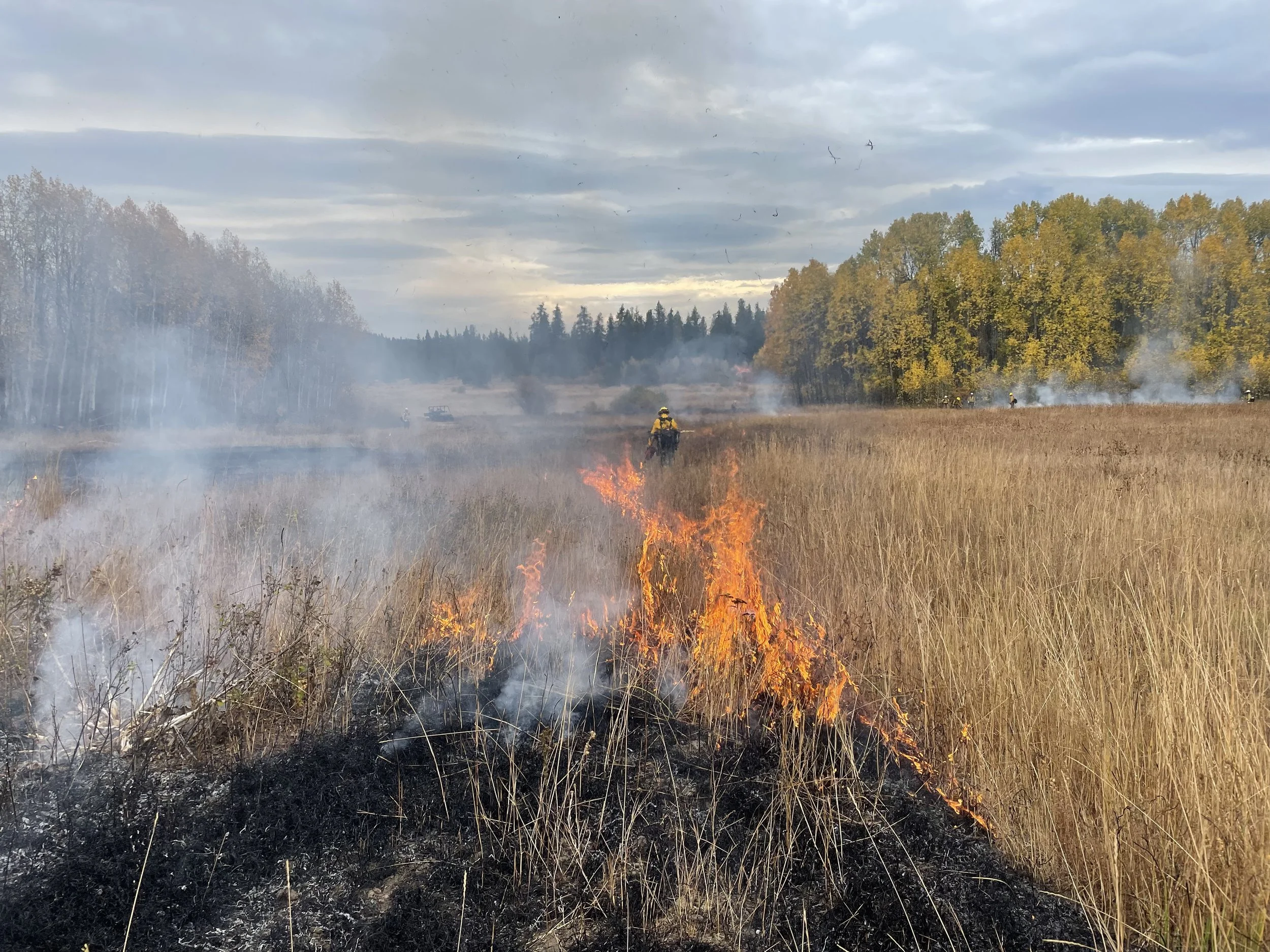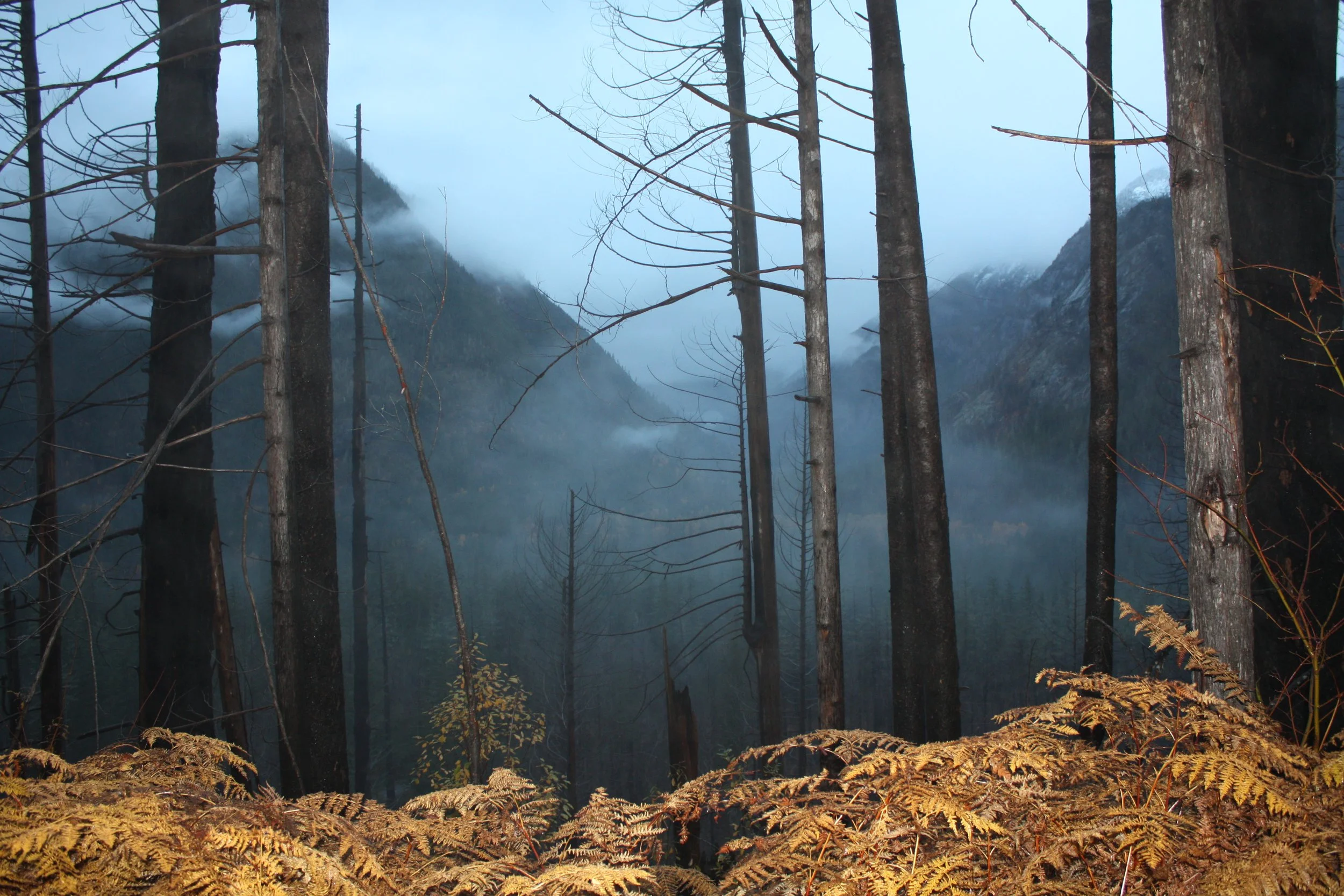The Unlikely Protectors of Washington’s Forests
The so-called ‘enemies’ of Washington state’s forests may be the heroes.
The flames of a Department of Natural Resource prescribed fire at Camas Meadows Natural Area, Fall 2022. This technique is used by tribes in central and eastern Washington and has since been adapted by land management agencies. // Photo provided by Washington State’s Department of Natural Resources.
Story by Caitlyn Wilson
December 6, 2023
On a cold and clear night, an ember caught. The fire danced across the mountainside, leaping from tree to tree. Quiet gusts of wind and a faint crackling sound echoed down the mountain. After the smoke cleared, the forest was a landscape of scalped trees and blackened shrubs.
Fires have always burned throughout the forests of Washington state, changing the landscape and impacting wildlife. Bark beetles too, have left their mark on Washington’s forests. Both fire and beetles are often portrayed in the media as harbingers of mass destruction. In reality, both play a role in the natural landscape and are key to forest health.
But climate change and other human influences have turned the protectors of the forest into enemies.
More severe periods of drought and warmer temperatures due to climate change weaken trees. Human involvement in fire suppression is also causing forests to become overgrown. This overgrowth results in weaker trees as less nutrients and water are available because of the high competition for resources.
Female bark beetles prey upon these weaker trees. The beetle searches for the delicious smell of fungus. Knowing the tree has lost its first line of defense, resin, she attacks. Resin is often overproduced in strong trees to create a sticky barrier to entry for any pesky beetles. Without those barriers, the beetle can chew tunnels under the bark until she reaches the area of the tree that stores and transports sugars, the phloem. This is the perfect spot to lay her eggs so that her young can feed on the sugars once hatched.
Inside look of mountain pine beetles burrowing into the phloem of the tree. This area of the tree stores sugars and is where the beetles lay their eggs. // Photo provided by Washington State’s Department of Natural Resources.
The trees often stand for months in their weakened state but cannot take up vital nutrients and water from the soil. Instead, they become nutrients for the rest of the forest as they fall and decay, adding to the rich layer of soil for more healthy trees to use.
“Bark beetles, they're all natives, we're not talking about any non-native invasive here. They're part of our forest ecosystem. And in low numbers, they're providing a really important ecosystem service,” Glenn Kohler, a Forest Entomologist for Washington State’s Department of Natural Resources (DNR )said.
Similarly, wildfires help forest health by removing undergrowth and recycling nutrients back into the soil.
Photo Caption: A broken and burnt tree in Sourdough Fire burn scar with burrow markings from bark beetles praying upon the weakened tree. // Photo by Caitlyn Wilson
But with wildfires becoming more intense and less predictable, they can cause severe damage to forest ecosystems. Likewise, colonies of bark beetles are growing large enough to prey upon live, healthy trees in Washington state. Longer summers and warmer winters due to climate change allow for bark beetles to consume forests at unprecedented rates.
In an aerial survey conducted in 2019 by the DNR, a little over half of total forest damage in Washington was due to bark beetle infestation. And at the end of the 2022 fire season, close to 56,000 acres of DNR land were ravaged by wildfires.
The effects of climate change have increased high-intensity and longer wildfire seasons, as well as allowed for warmer temperatures for beetles to breed and reproduce at higher rates and for longer. However, humans are working on strategies to once again utilize fires and beetles as effective caretakers of Washington’s forests.
One of these strategies is to work with fires to proactively manage forests.
Low-severity fires have been known to reduce forest density that can lead to high-risk fires and infestations as well as improve habitat for wildlife, according to the National Forest Foundation.
Tall undergrowth increases the likelihood of crown fires (fires that spread from tree top to tree top) or more severe wildfires, according to Basil Humke, a fire chipping crew member in Washington state. He works with high-severity wildfires rampaging through forests, shoveling up tree branches and other flammable materials into a chipper to adapt them into a fire-resistant woodchip.
Indigenous communities have used fire to shape the landscape and protect the natural resources of forests for over a millennium in Washington state using cultural burning, according to the National Parks Service. These strategies have been suppressed by the federal government since at least the 20th century, but just within the past few decades the practice has been reinstated in some areas, including in Washington’s forests. Cultural burning prevents more large, uncontrollable fires from igniting.
These proactive land treatments like traditional and modern prescribed burns, as well as manual thinning of overgrowth by fire crewmembers like Humke are necessary to prevent loss of resources through fire and beetle infestations. Tribes in central and eastern Washington have practiced prescribed burns since time immemorial. Recently, land management agencies have begun to rekindle the practice on DNR land, which allows for cultural practices, natural resources, and forests to prosper.
The aftermath of the severe 2023 Sourdough fire in North Cascades National Park. // Photo by Caitlyn Wilson
Washington State’s DNR developed the Prescribed Fire Program in 2021 to encourage forest restoration in central and eastern Washington and prevent severe wildfires.
Through this program, land management agencies are actively removing unnecessary vegetation and tinder that can lead to high severity fires. By reintroducing these techniques used by Indigenous communities in the area, forests begin to look and function like the healthy forests of the past.
“Every single time I tell someone about wildfires, the reaction is ‘hopefully we don't have any this season’ and it's actually good that we have at least some,” Humke said.
In addition to prescribed burns, community resilience is also vital to minimize the negative impacts of wildfires and beetle kill, and amplify their benefits. Here in Washington state, having buffers between houses and forest areas or changing the types of shingles used while building houses can prevent disturbances from affecting humans, according to Dr. Michael Medler, a College of the Environment professor at Western Washington University.
This would allow disturbances, such as fires, to conduct their natural processes and increase human capacity to withstand them.
“We're seeing things happening that didn't used to happen,” Medler said. “What does one need to think about? Resilience.”
Caitlyn Wilson is an environmental studies major at Western Washington University. She is interested in learning about and promoting environmental and community resilience.




